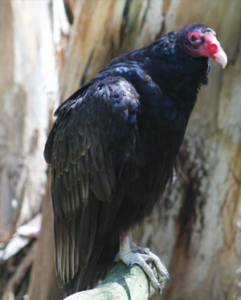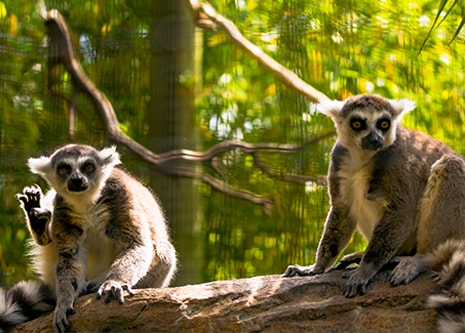
- VisitSupport Happy HollowDONATE TODAYExploreSupport Happy HollowDONATE TODAYLearnSupport Happy HollowDONATE TODAYSupport
-
Today's Hours: 10:00 am to 5:00 pm
Zoo in the HollowTurkey vultures

Scientific name: Cathartes aura
Family: Cathartidae
Order: Incertae sedis
Class: Aves
Range: North and South America
Habitat: Desert, temperate and tropical forest and rainforest, urban
Lifespan: Up to 16 years in the wild; Up to 20 years in captivity; Oldest on record was 37 yearsWhat do they look like?
Turkey vultures are large birds weighing two to five pounds with a wingspan of up to five feet. Those found farther north tend to be larger than their counterparts in tropical regions. Their bodies are covered in brownish-black feathers, with their flight feathers revealing a grayish color underneath. Their feet are flat with four toes, three in front and one in the back. Turkey vultures have relatively small, red heads that are not covered in feathers. The bald head of a turkey vulture allows it to keep itself clean when eating a carcass (body of a dead animal).How do they behave?
Turkey vultures roost communally, but typically forage independently. Although most birds do not have a well-developed sense of smell, turkey vultures have an acute sense of smell in addition to a great sense of sight to locate food sources. These birds will consume large amounts of carrion (dead animals) at a time, so much in fact that they may become too heavy to fly. If a predator approaches when the bird is weighed down with a large meal, the turkey vulture will projectile vomit in their direction. They may simply vomit to become light enough to flee from the situation and/or the regurgitated food may be used to distract the predator while the bird flies away. Like other large flighted birds, turkey vultures use thermal air currents while in flight to soar for long periods of time without expending much energy. Turkey vultures are efficient flyers and will often tip back and forth in the sky to maximize their flight before beating their wings. Turkey vultures do not make many vocalizations, but will hiss and grunt occasionally to communicate with one another.What do they eat?
Vultures primarily feed on carrion. Occasionally, turkey vultures may also feed on stranded seashore invertebrates, small mice, and insects. At Happy Hollow they eat rats, mice, quail, chicks and ground pork meat.How are they born?
Turkey vultures nest on cliffs, on the ground, or in caves. They lay one clutch of one to three cream colored, speckled eggs per year. Both the male and female incubate the eggs and care for the young. Eggs are incubated for approximately 40 days and the babies hatch with white down feathers and dark grey heads. The young birds fledge (take flight) 70 to 80 days after hatching. By the time the vultures approach their first birthday, their dark grey heads turn the characteristically red color.Conservation
Turkey vultures are currently listed as a species of Least Concern by the International Union for Conservation of Nature . However, turkey vultures are still impacted by habitat loss and other human influences, such as the use of rodenticides (chemicals used to poison rodents). Remember, turkey vultures are essential to many ecosystems because they clean up dead animal carcasses, stopping the spread of bacteria and disease. If these carcasses contain poison they can poison and kill the turkey vulture eating them. There are international conservation groups working to support vulture conservation, such as BirdLife International, which manages habitat and supports researchers who monitor and study global bird populations and species. To help ensure that the turkey vulture remains a species of least concern, you can avoid using rat poison to control pest populations. This will not only keep prey animals safe for vultures to eat, but will also make your yard safer for children and pets.
Zoo on the Hill
Located across from the Keep-Around Carousel is the Zoo on the Hill. Learn about wildlife up close during daily meet-and-greets, leap like a lemur on the playground, brush and feed the goats,, or take a peek inside Doc’s Critter Care building and the Ranch House. Double-H Ranch features a combination of animal exhibits, including giant anteaters and red ruffed lemurs, as well chickens and domesticated animals that are docile enough to touch.
See Animals
Education Ambassadors
From camps and classes to scout badges and sleepovers, Happy Hollow education programs have something for everyone! The zoo education program offers a broad range of hands-on, engaging programs and public presentations featuring education ambassador animals. These encounters are designed to connect you to wildlife and the conservation of their habitats around the world.
See AnimalsVisit Us Today
Plan an unforgettable experience at San Jose’s family-friendly park and zoo.
Learn More